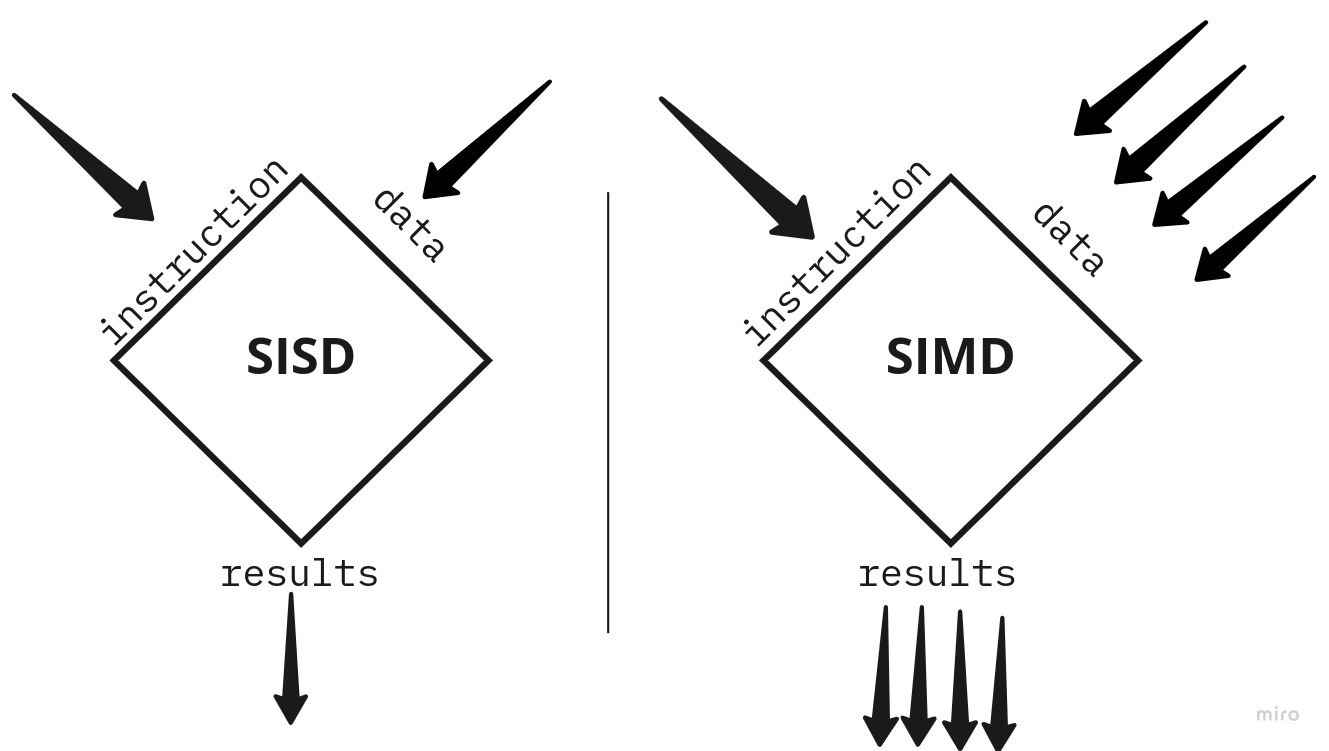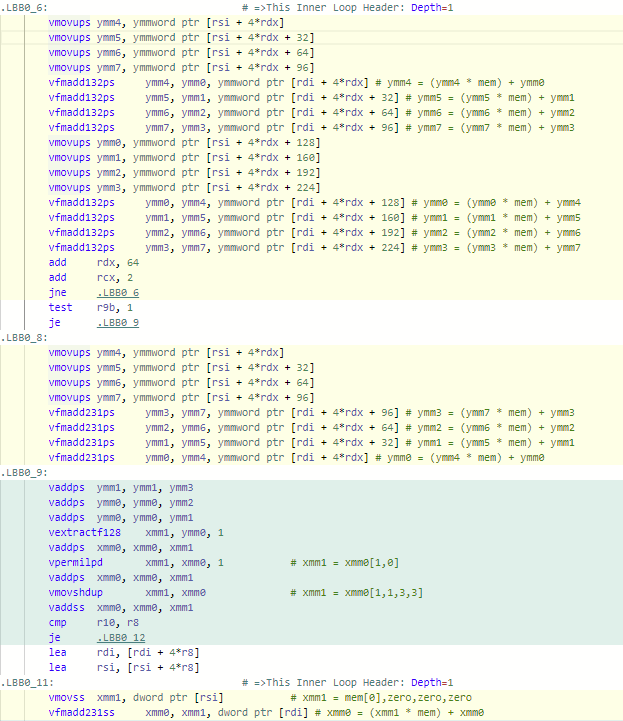Photo by Enric Moreu on Unsplash
A few weeks ago, I came across this interesting paper, Parsing Gigabytes of JSON per Second. 2.5 Gigabytes of JSON per second on commodity processors, to be precise. Three pages into the paper, I discovered that I needed more background knowledge on SIMD instructions. SIMD is like the Mona Lisa, I have an idea of what it looks like, but that representation is far from the actual painting. After reading a few articles and numerous build errors later, I’m confident enough to write on the topic.

SIMD, short for Single Instruction Multiple Data, is a parallel processing model that applies a single operation to multiple sets of vectors. If you’re not familiar with SIMD, there are several great introductory articles and slides on the topic.
the setup
I chose to benchmark the dot product operation because it’s a cheap operation, constrained only by the input size. The input consists of two float vectors, a and b, each of size n.

Where a and b are vectors, n is the size of the vectors, and ai & bi are vector components belonging to vectors a & b.
// Representation in pseudocode
number function dot_product(a[], b[], n) {
sum = 0;
for (i = 0; i <= n; i++) {
sum = a[i] + b[i];
}
return sum;
}
The input size is computed as n x float size (bytes) x number of vectors (2). To avoid memory shortage, I capped the input size at 256 MB (two 128 MB vectors).
I ran all my benchmarks on a Quad core Intel Core i7-8550U CPU with a 1MB L2 cache and an 8MB L3 cache. This CPU supports AVX2.
implementation
I started by comparing two functions, a scalar implementation, and a vectorized implementation.
The first implementation matches the pseudocode example above. A loop that runs n times, adding the result of a[i] x b[i] to the variable sum.
The vectorized implementation follows the same pattern but has several key differences. Firstly, all the key variables are type __m256, a data type representing a 256-bit SIMD register. In simple terms, this is a vector of eight 32-bit floating-point values.
The loop count increments by eight because the function _mm256_loadu_ps (L21, L22) loads eight floating-point values from unaligned memory into a __m256 vector. The function _mm256_fmadd_ps multiplies matching elements from the first two vectors and adds them to the value in the matching index of the third vector. To ensure correct computations, I added an assert on L16 to ensure the input arrays size is a multiple of 8.
The function _mm256_storeu_ps moves eight floating-point values from a __m256 vector to an unaligned memory location.
compare results
I used google/benchmark to run my benchmarks.
Benchmark Time CPU Time Old Time New CPU Old CPU New ----------------------------------------------------------------------------------- [dot_product vs. dot_product_256]/1 -0.8158 -0.8158 155357 28624 155354 28623 [dot_product vs. dot_product_256]/2 -0.8117 -0.8117 302681 56987 302667 56987 [dot_product vs. dot_product_256]/4 -0.8004 -0.8004 595212 118786 595200 118786 [dot_product vs. dot_product_256]/8 -0.7486 -0.7486 1260476 316823 1260469 316824 [dot_product vs. dot_product_256]/16 -0.6466 -0.6466 2711183 958018 2711140 957993 [dot_product vs. dot_product_256]/32 -0.6019 -0.6019 5450561 2169969 5450430 2169929 [dot_product vs. dot_product_256]/64 -0.5795 -0.5795 11411248 4797997 11411161 4797871 [dot_product vs. dot_product_256]/128 -0.5781 -0.5781 23172851 9776048 23172549 9775924 [dot_product vs. dot_product_256]/256 -0.5554 -0.5554 44252652 19673917 44251304 19673560
Each row represents a comparison between dot_product and dot_product_256 with different input sizes. The values in Time and CPU columns are calculated as (new - old) / |old| (x 100 to get percentage). The last four columns are time measurements in nanoseconds.
I expected dot_product_256 to be faster, but I did not anticipate the big gap. 81.58% faster with an input size of 1MB, 55.54% faster with an input size of 256MB.

analysis I
You can view the full analysis on Compiler Explorer.

The scalar implementation has three AVX instructions corresponding to the loop statement sum += a[0] * b[0];:
- vmovss unloads the pointer value
a[0]into a 128 bit register. - vmulss multiplies the value
a[0]with the value at pointer referenceb[0]. - vaddss adds the result from the multiplication operation above to
sum.
Compare that with the vectorized implementation instructions:

- vmovups loads eight floating-point values from
ainto a SIMD register. - vfmadd231ps multiplies the eight floating-point values loaded from
awith eight floating-point values loaded fromband adds the result tosum.
The xmm0-xmm7 registers used in the scalar implementations are 128 bit wide. In contrast, the vectorized implementation uses ymm0-ymm7 registers, which are 256 bit wide. The letters FMA in vfmadd231ps stand for Fused Multiply-Add, the technical term for the floating-point operation of multiplication and addition in one step.
compiler optimization
Up until this point, I’ve been using conservative optimization compiler flags -O3 and -march=native. I wanted to test another flag -ffast-math, which tells the compiler to perform more aggressive floating-point optimizations. Very similar to cutting the brakes on your car to make it go faster.
Benchmark Time CPU Time Old Time New CPU Old CPU New ----------------------------------------------------------------------------------- [dot_product vs. dot_product_256]/1 -0.0500 -0.0500 25535 24258 25535 24257 [dot_product vs. dot_product_256]/2 -0.0556 -0.0556 51505 48644 51504 48642 [dot_product vs. dot_product_256]/4 -0.0546 -0.0546 105722 99951 105718 99949 [dot_product vs. dot_product_256]/8 -0.1465 -0.1465 385659 329162 385646 329135 [dot_product vs. dot_product_256]/16 +0.0208 +0.0208 949516 969264 949485 969199 [dot_product vs. dot_product_256]/32 -0.0118 -0.0118 2301268 2274091 2301235 2274021 [dot_product vs. dot_product_256]/64 +0.0037 +0.0037 4863097 4881084 4862852 4880919 [dot_product vs. dot_product_256]/128 +0.0220 +0.0220 9883521 10101137 9883309 10101054 [dot_product vs. dot_product_256]/256 +0.0273 +0.0273 19079586 19601290 19079604 19600141
Both functions benchmark at almost equal speeds. dot_product_256 has the biggest lead, 14.65% (input size, 8 MB). dot_product is 2.73% faster on the largest input size, 256 MB.

analysis II
You can view the full analysis on Compiler Explorer

The scalar implementation compiled looks very different. The loop statement sum += a[0] * b[0]; now has 29 corresponding Assembly instructions. The compiler applied loop unrolling, an optimization strategy that minimizes the cost of loop overhead. The loop unrolls in four iterations. By examining one iteration, you’ll notice the use of 256 bit registers and SIMD intrinsics.
# First iteration: L33 - L40
vmovups ymm4, ymmword ptr [rsi + 4*rdx]
vmovups ymm5, ymmword ptr [rsi + 4*rdx + 32]
vmovups ymm6, ymmword ptr [rsi + 4*rdx + 64]
vmovups ymm7, ymmword ptr [rsi + 4*rdx + 96]
vfmadd132ps ymm4, ymm0, ymmword ptr [rdi + 4*rdx] # ymm4 = (ymm4 * mem) + ymm0
vfmadd132ps ymm5, ymm1, ymmword ptr [rdi + 4*rdx + 32] # ymm5 = (ymm5 * mem) + ymm1
vfmadd132ps ymm6, ymm2, ymmword ptr [rdi + 4*rdx + 64] # ymm6 = (ymm6 * mem) + ymm2
vfmadd132ps ymm7, ymm3, ymmword ptr [rdi + 4*rdx + 96] # ymm7 = (ymm7 * mem) + ymm3
Conclusion
Thanks to compiler optimization, the scalar implementation matches the vector implementation performance-wise. Both cases use SIMD registers and intrinsics, whether intentionally written or optimized later by the compiler. The optimized implementations handle larger data sets faster, but they have limits too.
Hardware, specifically the CPU, is the determining factor when optimizing with SIMD. Most modern CPUs support AVX2, fewer support AVX2-512 (512 bit wide registers).



